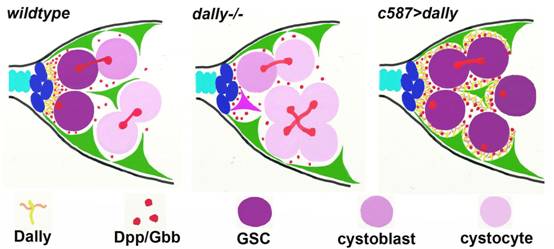Drosophila ovary is an excellent system to study germline stem cell (GSC) biology. 2~3 female GSCs are maintained constantly in a structure called niche at the anterior tip of ovary. The somatic niche cells surrounding the GSCs include terminal filament (TF) cells, cap cells, and escort stem cells. Mounting evidence have demonstrated that BMP-like morphogens are the immediate upstream signals to promote GSC fate by preventing the expression of Bam, a key differentiation factor. Being a morphogen but unlike its behavior in imaginal epithelia, BMP molecules induce distinct cell fates between the adjacent GSCs and cystoblasts in ovarian niche. How this steep gradient of BMP-response is achieved remains elusive. In this study, we found that glypican Dally is essential for maintaining GSC identity. Dally is highly expressed in cap cells. The Cell-specific Dally-RNAi and Cell-specific rescue of GSC loss suggest that Dally acts in the cap cells adjacent to GSCs in the niche. We confirmed that Dally facilitated BMP signaling in GSC by examining its downstream targets in various dally mutant flies. Conversely, when we over-expressed Dally in all somatic cells, we apparently expanded the pro-GSC microenvironment and consequently increased the number of GSC-like cells. Furthermore, in a genetic setting we revealed a BMP-sensitivity distinction between germline and somatic cells, i.e., Dally is required for the short-range BMP signaling in germline but not in somatic cells. We propose that Dally expression in cap cells restricts BMP signaling and thus GSC fate to the niche.

Niche-localized Dally promotes GSC fate determination.
How the fate of germ cells changes in different genetic conditions are summarized in these cartoons, where the relationship between Dally and Dpp/Gbb (Drosophila BMP molecules) distributions, as well as the differential effect on germline and somatic cells, are considered. The somatic cells in the illustrations are: TF (light blue), cap cells (dark blue), escort cells (green and purple triangular). In wildtype, cap cell-expressed Dally induces high BMP-response in 1-cell range to ensure GSC fate in the niche. Removal of Dally (dally-/-) makes BMP molecules less concentrated in the niche and germ cells unable to evoke a BMP-response, and consequently GSCs are lost.Somatic escort cells, however, can elicit BMP-response in the absence of Dally(in dally-/-, the purple triangle cell next to the cap cells). When Dally is over-expressed beyond the niche (c587>dally), GSCs are accumulated in the germarian spaces in addition to the niche. It appears that extra Dally can expand the pro-GSC microenvironment and such activity of Dally requires membrane-anchoring.



